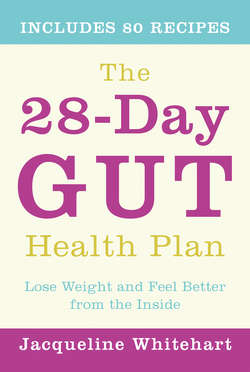Читать книгу The 28-Day Gut Health Plan: Lose weight and feel better from the inside - Jacqueline Whitehart, Jacqueline Whitehart - Страница 14
EVERYBODY IS DIFFERENT
ОглавлениеMY OWN JOURNEY
Jacqueline, in her forties
Symptoms – bloating
I used to feel bloated even after eating a small meal. Bloating is so subjective, it’s hard to know the exact cause and solution. I didn’t tend to feel poorly, so it was hard to pin it down to any one cause. I also got eczema on my face and had a tendency to migraines.
After much experimentation last year (this programme is intended to cut out the grey areas allowing you to reach your own conclusions much quicker), I discovered that wheat was the problem. The difficulty is that with bloating caused by wheat intolerance (which is so common), it doesn’t come straight after eating wheat; it comes maybe a day later and lasts about forty-eight hours. So if I eat wheat on the Monday, I might not get symptoms until Tuesday and they won’t completely disappear until Thursday. It’s so easy to eat a little bit of wheat every day and then the bloating never really goes away.
I cut out wheat completely for a few months and felt a lot better for it. My eczema cleared up nicely and the frequency of my migraines decreased. All due to cutting out wheat.
That’s not quite the end of the story. And this may be familiar to some of you. I was feeling better and I knew this was due to cutting out wheat. I wanted to try and reintroduce it slowly. I missed bread. And the first few times I experimented with bread it seemed fine. A bit of bloating the day after eating wheat is easy to overlook. Unfortunately, this led to me, almost imperceptibly, going back to eating wheat every day. And slowly but surely my symptoms returned. It took seeing my stomach in the mirror to acknowledge it. My tummy was not fatty or flabby … just bloated.
My new plan, which I have been following successfully for the past few months, is to cut out wheat entirely once again. But I make a wheat-free loaf of bread and eat gluten-free bread most days (see here). I have to use a rice flour to make the bread, which isn’t ideal. But I have realized that total wheat restriction is no fun in the long run. So my long-term rules for me are: no wheat and no processed foods. But if I want to eat chocolate, gluten-free bread or make some cookies containing real sugar, I do.
Let’s hear from some other people I have helped find their own trigger foods, and who enjoy their life more due to a greater understanding of their gut health.
ANGELA
Angela, in her fifties
Symptoms – stomach cramps at night
Angela has been getting stomach cramps at night for thirty years. Not every night, but sometimes they are so bad that she barely sleeps at all. She noticed a correlation with nightshade, so for a long time she has avoided tomatoes in all their forms. Her symptoms became progressively worse over the years. She then tried removing wheat and dairy from her diet with little success.
It was only on total removal of all gas-producing foods that her symptoms improved.
Angela’s triggers are nightshade and gas-producing vegetables. In particular, she knows that even a tiny bit of onion or garlic will trigger her symptoms. Tomatoes in small doses and cooked tinned tomatoes are less of a problem.
Her solution is to avoid onions, garlic, leeks, beans and lentils totally. She also takes probiotics when her stomach is weak or when she needs antibiotics. She takes a fibre supplement (a teaspoon of ground psyllium) daily.
Angela allows herself to consume tomatoes and peppers in small amounts up to three times a week. She also eats wheat and dairy freely.
STEPHEN
Stephen, in his forties
Symptoms – loose bowels
Stephen is a busy executive who has a stressful job. In a particularly difficult period at work, his symptoms became unbearable and made it difficult for him to do his job properly.
On the advice of the doctor, he cut out all five triggers until his symptoms abated. Then, after a long period of trial and error, it became clear that it was the milk in his many cups of tea that was the problem. Stress also exacerbated the symptoms. His treatment involved probiotics for three weeks to rebuild the gut.
He now does not have milk or yogurt, although cheese is fine. He also is careful about how much red meat he eats. Meat in moderation is fine, but overindulgence can cause his symptoms to reappear.
ANTONIA
Antonia, in her thirties
Symptoms – severe stomach cramps, bloating
Antonia found her symptoms were making her miserable and interfering with her life. She chose to take a food-intolerance test, which highlighted red meat, milk and wheat.
Antonia avoids these three triggers entirely and she is now symptom-free.
JOHN
John, in his seventies
Symptoms – bloating
John didn’t feel he had any intolerances or symptoms. However, he did notice that he was bloated after meals and struggled to lose weight despite eating more healthily. John consumed a lot of wheat (as many of us do), so he decided to cut it out for one month to see if he noticed the difference. After a month wheat-free he felt so much better – more energy, no bloating and yes … he’d lost half a stone.
John now eats wheat only on special occasions – a rustic roll in a restaurant or a piece of homemade birthday cake – with no symptoms, but he knows that if he eats wheat more regularly his symptoms will return.
